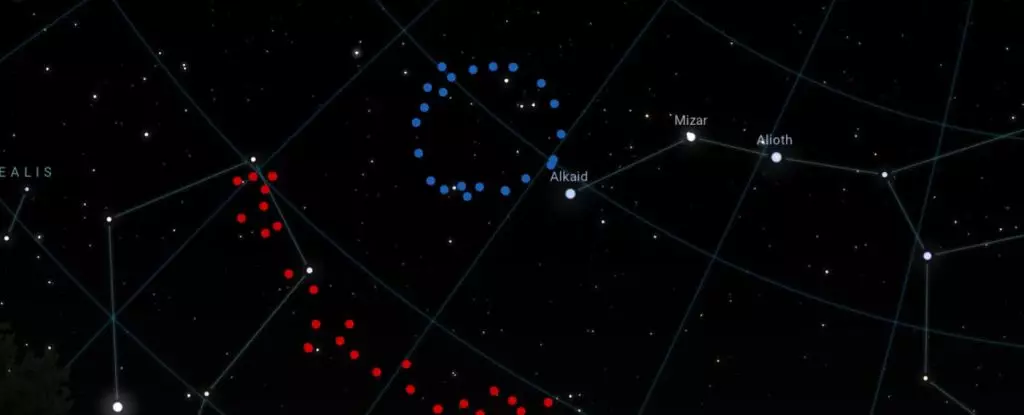The Universe is a vast and unfathomable expanse, filled with intricate structures and phenomena that continuously challenge our understanding of physics and cosmology. Among the latest revelations to emerge from this great cosmic book is a colossal formation named the Big Ring, a near-perfect arrangement of galaxies that is approximately 1.3 billion light-years in diameter. Astronomers, led by Alexia Lopez from the University of Central Lancashire, have struck upon a discovery that not only stretches the bounds of current cosmological knowledge but also poses significant questions about the very essence of our Universe.
The Big Ring is unlike any structure recorded in the astronomical annals, as it fails to align with our existing models of galaxy formation and distribution. Presented at the 243rd meeting of the American Astronomical Society, the implications of this discovery were spellbinding. Lopez’s team previously unveiled the Giant Arc, another mysterious large-scale structure, in 2021. However, the Big Ring compounds the enigma that surrounding these sizable formations. The pivotal query arises: what does it mean for our preconceived notions of cosmic evolution?
The vastness of the Big Ring challenges the established cosmological principle, which suggests that the distribution of matter in the Universe should be homogenous on a grand scale. Lopez pointed out that current calculations suggest an upper limit for cosmic structures at around 1.2 billion light-years. The discovery of the Big Ring and the Giant Arc unapologetically subverts the conventional wisdom within the field of cosmology.
In the quest to understand this giant formation, Lopez’s findings hinted at a trickle of connection to Baryon Acoustic Oscillations (BAOs)—circular configurations of galaxies that acted as echoes from the primordial Universe. However, the Big Ring diverges from BAOs both in its size and shape. BAOs are consistently sized at about one billion light-years, existing as remnants of sound waves that once traveled through the early Universe. Conversely, the analysis of the Big Ring reveals a corkscrew-like alignment, forcing us to consider alternative cosmological explanations.
This deviation raises a multitude of avenues worth exploring. One notion is the existence of cosmic strings—defects within the fabric of space-time that may have formed shortly after the Big Bang. If true, these cosmic strings could serve as a scaffold upon which galaxies might assemble, creating unprecedented structures like the Big Ring.
The intellectual pursuit of understanding what the Big Ring represents asks us to reconsider our cosmological models. The traditional framework, while robust and informative, does not entirely accommodate such gargantuan structures. Theories such as Roger Penrose’s conformal cyclic cosmology attempt to clarify the situation by proposing that the Universe undergoes endless cycles of evolution, marked by successive Big Bangs. However, this idea too faces significant scrutiny, as it must resolve its own internal inconsistencies.
The implications of the Big Ring and the Giant Arc extend beyond scientific curiosity and probe deeper into philosophical realms. They force astronomers and cosmologists to engage in a fundamental reevaluation of the Universe’s archetypes. Was our understanding of space and time limited, blissfully ignorant of more intricate patterns lurking within the cosmic void?
Even as astronomers grapple with the theoretical complexities of the Big Ring, there is a palpable desire to locate more such structures within the expansive Universe. The possibility that these colossal formations are mere coincidences in the grand tapestry of the cosmos seems increasingly unlikely. Lopez encapsulated this sentiment perfectly: we did not expect such structures to exist within our observable Universe, leading to an intellectual quandary that challenges the very foundation of our understanding.
To unveil the true essence of these enormous alignments, further investigations are essential. Are there more examples hidden throughout different sectors of the Universe? Could these forms yield insights into the possibly unforeseen ramifications of both the Big Bang and subsequent cosmic evolution?
As astronomers delve deeper into the mysteries of the Big Ring, they are beckoning humanity to re-examine its relationship with the Universe. We stand not only on the precipice of astronomical discovery but also at the crossroads of profound philosophical and scientific transformation. The question remains: will we uncover the truths that lie beyond our current understanding or will we, once again, be left to ponder the infinite complexities of the cosmos?


Leave a Reply